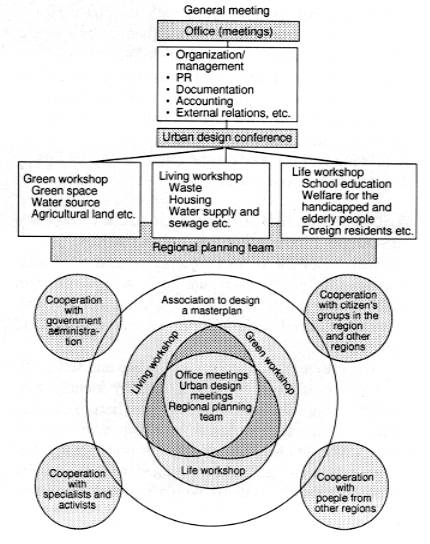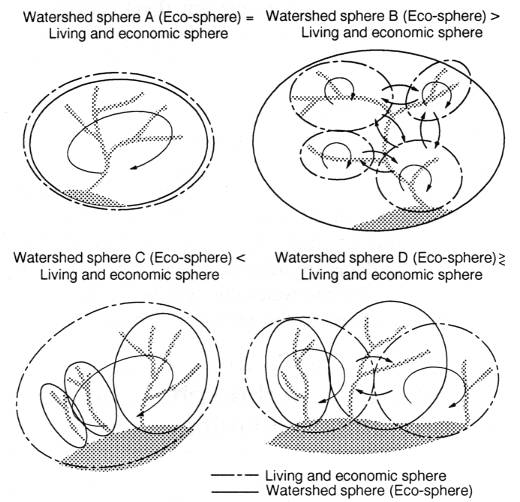Chapter II :Quality of the Environment in Japan 1998
Chapter II: Development of Local Communities with "Sound Material Cycle" and "Coexistence of Nature and Human Being", from the Viewpoint of Japan's Land Use
3. Measures in the sphere based on human activities
Here we define areas where certain systematic human activities occur, which are conducted to some extent with a view to achieving harmonisation with the mechanisms of nature, as "living and economic spheres."
Measures with consideration of living and economic spheres
In 1995, the "Hino City masterplan of citizens' version" was drawn up by the citizens of Hino City, Tokyo. With the key concept of self-support and maturity on the part of the city, this masterplan suggests means of protecting the water and the agriculture of Hino City.
Organizational Structure of the Association to Design a Masterplan

Source: Hino City Masterplan
Growth management of cities and attempts at administration beyond the local level
In Japan, approx. 70% of the population lives in urban areas. It is therefore an important task to create cities where our daily lives and economic activities take place in as sustainable a way as is possible and in harmony with the mechanisms of nature. In the US, where people are highly dependent on cars for transport, some measures are being undertaken to achieve appropriate growth management of cities and discourage the over-dependency on automobile transportation.
For example, in the urban area around Portland "the Region 2040 Growth Concept" was set up by a "wide-area" administrative organization "Metro," established by three counties with the City of Portland as its center. Included in the plan are land-use planning to prevent the chaotic sprawling of the urban area, and transport systems that are coordinated with the land-use planning and which will also lead to reduction of environmental impacts. Also, the Portland area's "Regional Transportation Plan" is promoting transport policy with a balanced combination of walking, cycling, public transport, freight traffic, and road transport.
Keep the history of coexistence of nature and humans
Human beings have lived with various blessings and influences from nature, while themselves exerting influence on nature. In the past, village woods, rice paddies, fields and residential areas used to be created in harmony with the mechanisms of nature. Each regional area has its own characteristic climate, natural features, culture and history. It is one of the necessities in a living and economic sphere to consider its history of harmonious coexistence of nature and human being.
Appropriate introduction of local resource circularity within a region
It is important to ensure proper circularity of local resources within the communities in accordance with existing natural mechanisms for realization of a system of sound material cycle and coexistence of nature and human being.
The use of composted organic waste and self-sufficient food production by environmentally friendly agriculture that utilises such compost have become topical recently as such approaches achieve both environmental conservation and healthy life styles. It is also being suggested that water and energy should be provided by small-scale supply systems within regional communities.
Cooperation and independence in local communities
In a living and economic sphere it is desirable that diverse components collaborate each other and that the self-support of the local community is ensured. That is, it is important to establish respect for the complementary relationship of natural mechanisms such as water and air, the circularity of various substances within the community, and cooperation between administration, companies and citizens to support the circularity. Cooperation between various industries such as manufacturing and agriculture, and between residential, agricultural and commercial areas should also be respected. With these various components coexisting in the community, and with the close links and collaboration of such components, it becomes possible to develop self-sufficient local communities which properly utilize existing natural mechanisms in a way that reduces negative impacts on the environment.
Community development within human perspective
Due to the expansion of areas of human activities and the specialization of economic activities, it is becoming more difficult to have a picture of human activities as a whole. In a living and economic sphere it is desirable to promote community development within human perspective, while making the most of existing natural mechanisms. This can be achieved, for example, by developing small-scale systems for self-sufficient production of water and energy supply, and by the establishment of a self-supporting lifestyle involving local production and local consumption within the community.
Perspectives on the living and economic sphere
The living and economic sphere can realize richer "sound material cycle" and "coexistence of nature and human being" by establishing collaborative, complementary relationships with eco-spheres, watershed spheres of the same scale, while ensuring a certain degree of independence. Such relationships can take different forms depending on the scale and location of relevant spheres: whether a living and economic sphere corresponds with an eco-sphere and/or a watershed sphere, whether an eco-sphere and/or watershed sphere contain some living and economic spheres, or whether a living and economic sphere consists of some eco-spheres and/or watershed spheres.
Relationship between the Spheres

Source: Environment Agency